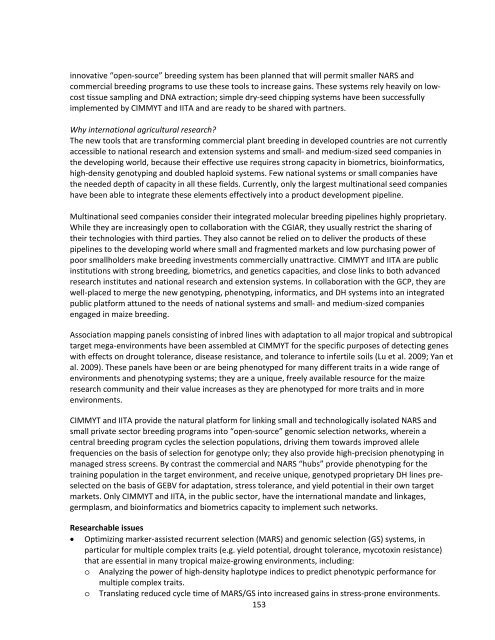Download - Maize
Download - Maize
Download - Maize
You also want an ePaper? Increase the reach of your titles
YUMPU automatically turns print PDFs into web optimized ePapers that Google loves.
innovative “open‐source” breeding system has been planned that will permit smaller NARS and<br />
commercial breeding programs to use these tools to increase gains. These systems rely heavily on lowcost<br />
tissue sampling and DNA extraction; simple dry‐seed chipping systems have been successfully<br />
implemented by CIMMYT and IITA and are ready to be shared with partners.<br />
Why international agricultural research?<br />
The new tools that are transforming commercial plant breeding in developed countries are not currently<br />
accessible to national research and extension systems and small‐ and medium‐sized seed companies in<br />
the developing world, because their effective use requires strong capacity in biometrics, bioinformatics,<br />
high‐density genotyping and doubled haploid systems. Few national systems or small companies have<br />
the needed depth of capacity in all these fields. Currently, only the largest multinational seed companies<br />
have been able to integrate these elements effectively into a product development pipeline.<br />
Multinational seed companies consider their integrated molecular breeding pipelines highly proprietary.<br />
While they are increasingly open to collaboration with the CGIAR, they usually restrict the sharing of<br />
their technologies with third parties. They also cannot be relied on to deliver the products of these<br />
pipelines to the developing world where small and fragmented markets and low purchasing power of<br />
poor smallholders make breeding investments commercially unattractive. CIMMYT and IITA are public<br />
institutions with strong breeding, biometrics, and genetics capacities, and close links to both advanced<br />
research institutes and national research and extension systems. In collaboration with the GCP, they are<br />
well‐placed to merge the new genotyping, phenotyping, informatics, and DH systems into an integrated<br />
public platform attuned to the needs of national systems and small‐ and medium‐sized companies<br />
engaged in maize breeding.<br />
Association mapping panels consisting of inbred lines with adaptation to all major tropical and subtropical<br />
target mega‐environments have been assembled at CIMMYT for the specific purposes of detecting genes<br />
with effects on drought tolerance, disease resistance, and tolerance to infertile soils (Lu et al. 2009; Yan et<br />
al. 2009). These panels have been or are being phenotyped for many different traits in a wide range of<br />
environments and phenotyping systems; they are a unique, freely available resource for the maize<br />
research community and their value increases as they are phenotyped for more traits and in more<br />
environments.<br />
CIMMYT and IITA provide the natural platform for linking small and technologically isolated NARS and<br />
small private sector breeding programs into “open‐source” genomic selection networks, wherein a<br />
central breeding program cycles the selection populations, driving them towards improved allele<br />
frequencies on the basis of selection for genotype only; they also provide high‐precision phenotyping in<br />
managed stress screens. By contrast the commercial and NARS “hubs” provide phenotyping for the<br />
training population in the target environment, and receive unique, genotyped proprietary DH lines preselected<br />
on the basis of GEBV for adaptation, stress tolerance, and yield potential in their own target<br />
markets. Only CIMMYT and IITA, in the public sector, have the international mandate and linkages,<br />
germplasm, and bioinformatics and biometrics capacity to implement such networks.<br />
Researchable issues<br />
Optimizing marker‐assisted recurrent selection (MARS) and genomic selection (GS) systems, in<br />
particular for multiple complex traits (e.g. yield potential, drought tolerance, mycotoxin resistance)<br />
that are essential in many tropical maize‐growing environments, including:<br />
o Analyzing the power of high‐density haplotype indices to predict phenotypic performance for<br />
multiple complex traits.<br />
o Translating reduced cycle time of MARS/GS into increased gains in stress‐prone environments.<br />
153

















